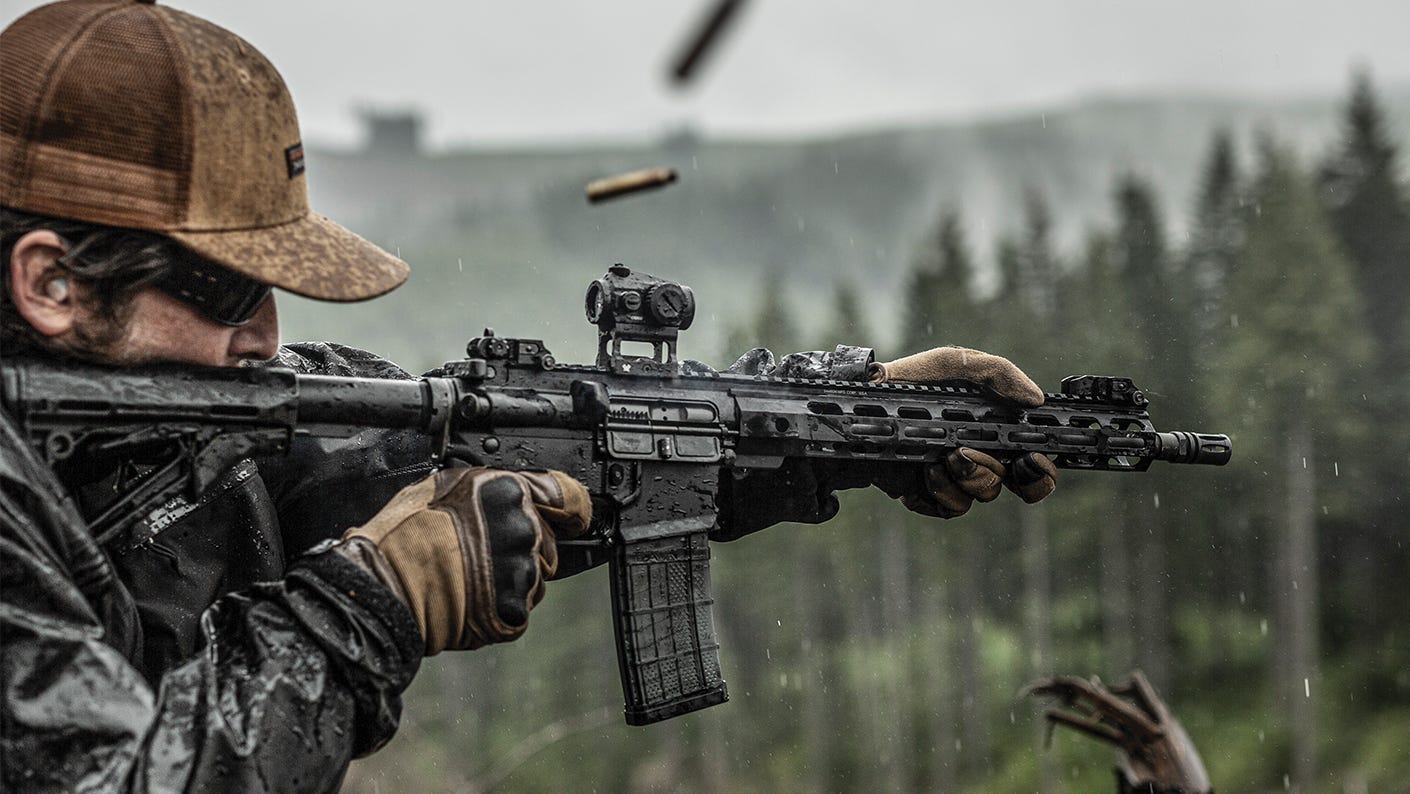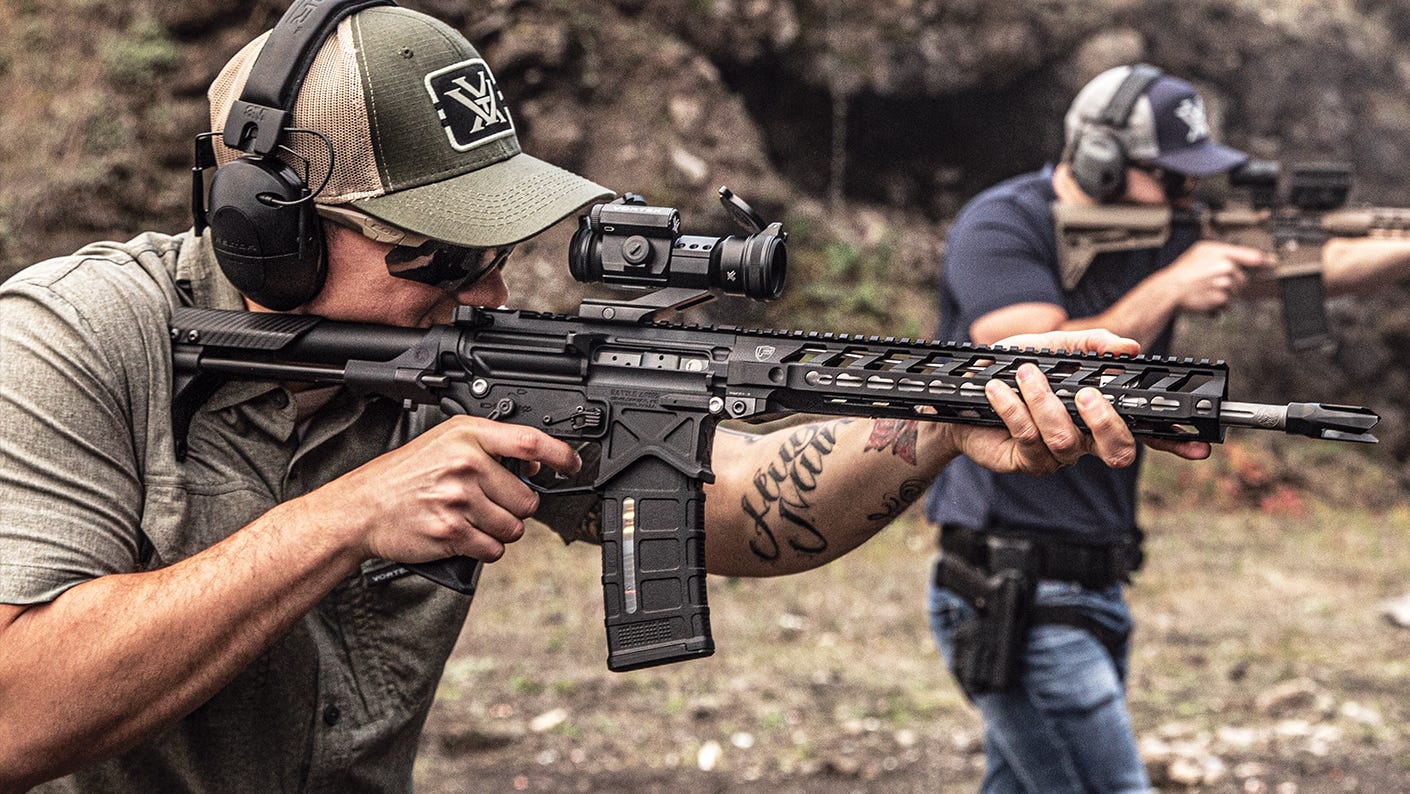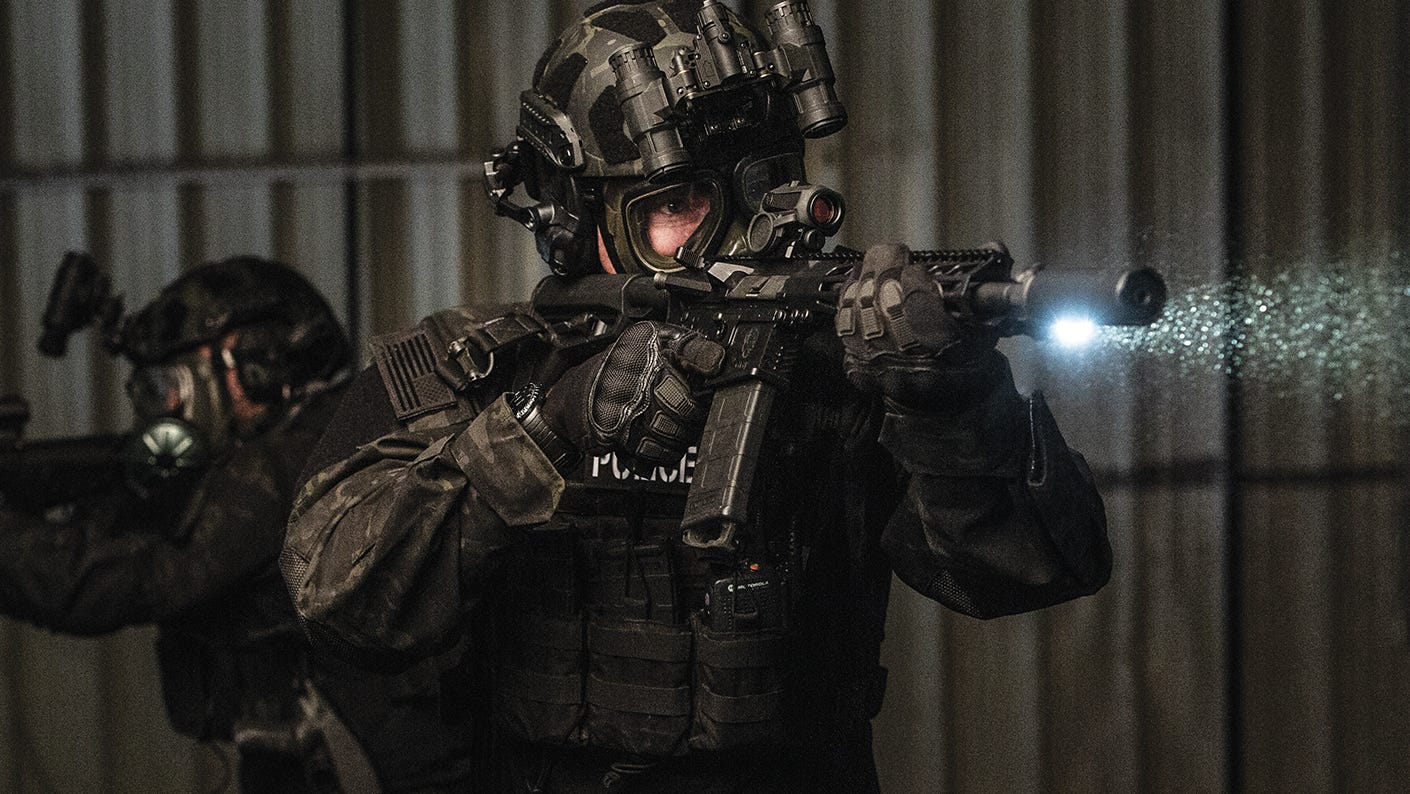What’s the best optic for your AR? Let’s talk red dots.

Is it really just as simple as “red dots for close in, LPVOs for distance?” Well, yes. And no …
If you’ve spent so much as five minutes Googling “Optics for my AR-15,” chances are you’re already aware the internet wants you to top it off with either a red dot or an “LPVO.” For those not yet privy to the cool-kid language, “LPVO” is short for “Low Power Variable Optic” which is jargon for any optic that starts on a true 1x magnification and goes to a higher mag like 4x, 6x, 8x, or even 10x in some cases.
Acronyms and jokes about information gathered from the internet aside (you are getting this information from the internet, too, after all) the general consensus is “Get a red dot if you only shoot 100 yards and in, and get an LPVO if you intend to shoot further than 100 yards.” Seems easy enough, but I can say at least for myself, I know there’s always exceptions to general rules of thumb, and I want to know as many of the ins and outs as I can to make the best decision for me and my exact application.
Over the years working at Vortex, I’ve answered thousands of questions around optics for AR-15’s and had thousands of my own as well. Maybe a few of these match questions of your own, or can bring in a new perspective you hadn’t thought of yet.
Here are some of the most frequently asked questions about the optics we put on our AR’s (We’ll start with red dots, then, next week, we’ll hit LPVOs):
Most common questions about red dots
“Why are there so many different shapes and sizes?”
With red dots, you’ve got little tiny open-top options (Like our Viper® or Venom®), Fully-enclosed micro dots (Like our Crossfire® or SPARC® AR), and even larger options that mount using regular riflescope rings (Like our 30mm Strikefire® II Red Dot). At their core, they all work the same – A small LED shines, and a parabolic lens reflects the image of the shining emitter back to your eye, giving you a “red dot” smack in the middle of your FOV, which you can sight-in and use as a point of aim. The various sizes and shapes just adapt this technology to better fit different firearm platforms and end user needs/preferences.
- Open top red dots (Like our Viper® or Venom®) – Shave as much of the aluminum housing away, at the expense of some inherent durability/bash-proofness in order to deliver a super small sight that fits on pretty much every firearm imaginable, including handguns. It also makes for a sight picture that’s almost completely uninhibited except for that lovely little floating red dot.
- Fully-enclosed micro red dots (Like our Crossfire® or SPARC® AR) – These things aren’t just tough as nails – they’re as tough as the hammers that drive them, thanks to the fully-enclosed aluminum housing that protects the optic’s relatively simple internals. They do this at the cost of more black aluminum to look through/around, but that’s a small price to pay for users who want the ultimate in durability.
- Full-sized enclosed red dots (Like our 30mm Strikefire® II) – These make up for the micro red dot’s tiny field of view through the optic by providing a larger viewing window. The tradeoff is that a bigger viewing window means a bigger body around it, which means more bulk and weight, relatively speaking.

Finding the best red dot comes down to knowing what you want to do with your rifle. Full-sized enclosed red dots like this give you a huge viewing window, but do add a little more weight.
“What’s the deal with “dot size?”
“Dot size” is a term we use to describe how much of your target down range the red dot will cover up, and therefore many shooters use this as a baseline for how accurate they can reasonably expect to be with that optic.
It’s usually measured in MOA rather than a linear unit of measure like inches/centimeters because it varies depending on your target’s range—for example, a 2 MOA dot will cover up *about* 2 inches of your target at 100 yards, but at 10 yards, it will only cover up *about* .2 inches. Just like how holding your thumb up in front of your face, you can make it cover up an entire skyscraper miles away, whereas it doesn’t even cover up one door handle of that building when you’re standing right next to it. Neither a large nor small dot size is better than the other; it all depends on what you’re looking to get out of the sight performance-wise.
- Large dot (6 MOA or bigger) – The human eye picks up on big, bright objects much quicker than it does little bright objects. Close-quarters shooting scenarios often rely on extreme speed and accuracy, and therefore, you need to be able to pick up your point of aim lightning-fast. Within 10 yards, even a bigger 6+ MOA dot is covering up less than an inch of your target, so you can still be precise with it, but your eye can pick it up much quicker than a smaller dot.
- Small dot (Less than 6 MOA) – Believe it or not, despite what the internet tells you, you can hit a target beyond 100 yards with a red dot plenty easily. It does help, if you intend to do it, to have a smaller dot, though. Just like surgeons don’t go into a complicated surgery with a set of grilling tongs, you wouldn’t want to try hitting a 12-inch target with a 5.56 projectile at 300 yards with a 6 MOA dot that’s covering up about 18 inches of space at that distance!
"How will I mount it?"
When it comes to mounting red dots, it’s the wild west out there, folks. There’s different heights, offsets, forms of attachment, quick release and non-quick release, etc. Luckily, most red dots will come with some kind of base that can usually be used perfectly fine, but sometimes you’ll have to switch it up. Since we’re only talking about AR-15’s here, that makes this a bit easier.
- Open top red dots – The mount most any open top red dot is going to come with is far too short to be used comfortably on an AR-15, so just know if this is the route you want to go, add in the cost of a mount to your budget right away. Note whether the mount you’re looking at is a “Direct mount” style or just a picatinny rail riser. “Direct mount” means the red dot will actually bolt to the mount itself, so you’ll have to be aware of the bolt/recoil lug pattern your optic uses and whether it’s compatible with the mount you want. For example, our Viper and Venom red dots share the same bolt/recoil lug pattern, and both use the “Vortex Mount Riser – QR” but our Razor® red dot would not be compatible with that mount because it is different. If you don’t want to worry, or want a riser mount that can be used with any optic, consider something like the “Vortex AR-15 Riser Mount” as it just gives a picatinny rail mounting platform compatible with any standard picatinny rail mount that pretty much every red dot comes with.
- Fully-enclosed micro red dots – A lot of these will come with a low mount like the open top red dots, but also a higher mount for AR-15’s. Everyone has their own personal preference as to what height they’d prefer for their red dot, so if you’d like to switch the one it came with for an aftermarket one with different features, that’s up to you.
- Full-sized enclosed red dots – Most of these aren’t going to come with a low mount in the box, but just an AR-15-height mount. Should you want to go to a different height or style of mount, you’ll be limited mostly to options for traditional riflescopes, being that these optics often just use a 30mm tube like a riflescope rather than being direct mount like their smaller cousins.

When mounting your optic, consider all the different scenarios in which you might be shooting. Many optics will come with a high and a low mount. How you plan on using your rifle, and your personal preference, will tell you how to mount up.
“Co-Witness?”
The term “Co-witness” is my least favorite term of all time. It’s in reference to your red dot’s sight height in relation to your iron sights and the term really gets people way too focused on how their red dot looks or “lines up” relative to their iron sights (whether fixed or flip-up style on your AR).
The two sighting systems themselves are 100% SEPARATE. You should sight them in separately and use them separately, no matter what the internet tells you. The whole point of a red dot is to be fast and to eliminate the need to have to line up more than one thing on multiple focal planes (i.e. – why irons are harder, slower, and more difficult to master).
If you can see and use your irons through the red dot when the red dot is turned off, even if they’re down in the very bottom of your red dot’s window, that’s good enough for a “Co-witness.” That just means if your red dot’s battery dies, leaving you with no point of aim anymore, you can at least go into “limp home mode” by using the irons through the red dot’s window until you can get a replacement battery.
Make sure to check out next week’s blog on the most common questions about putting an LPVO on your AR. In the meantime, checkout this
It’s our hope you can learn and laugh along with the expert voices we feature on this blog. We want to be clear that the opinions you see featured here are just that: opinions. The content belongs to the authors and is not necessarily the opinion of Vortex Optics.
To learn more about what you’ve read, please like, follow, and otherwise support our authors.










